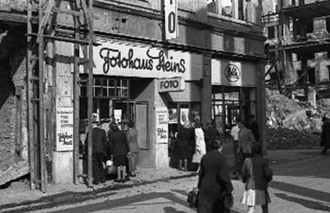
This book is about buying and selling in Nazi Germany. It seeks to understand how the daily business of producing, marketing, shopping, and consuming took place under a racist dictatorship. I pay especially close attention to advertising and consumer research, two themes that have received little attention from scholars of the Third Reich.
One of the book’s central arguments is that the Nazis maintained the basic functions of the consumer marketplace before World War II, whereby companies could sell their products and the public could respond to their ad campaigns. Gradually, the Nazis limited the opportunities for consumers, especially during the War, and they regulated supply and demand. But the semblance of normality related to the consumer marketplace helped sustain popular support for the Nazi regime and helped enable its crimes.
Creating the Nazi Marketplace begins with a focus on Nazi ideas about the marketplace. The Nazis had tremendous ambivalence about modern forms of commerce and consumption. On the one hand, they linked commercial capitalism to corrupt “Jewish” economic control and to crass American mass culture. On the other hand, they realized that consolidating support for Adolf Hitler’s dictatorship depended on creating an abundant, post-Depression society—indeed one that could compete with the United States.
The Nazis tried to create a purified “German” mass consumer society that protected the racial integrity of the Aryan population by reigning in “unhealthy” forms of competition. To realize this aim, they relied on the work of finished good companies and manufacturers that had a large customer base.
Three of these companies receive sustained attention in the book: Kaffee Hag, a producer of decaffeinated coffee; Bayer, the pharmaceuticals giant that marketed aspirin; and Henkel, the chemical company most famous for its Persil brand detergent.
All three were noted for their quality products and their creative advertising. As makers of a “healthier” form of coffee, of soaps, and of medicines, these firms were also valued in a society that celebrated the biological “purity” of its people.
I look at the ads, promotional films, publicity materials, and market research of these and other companies at peacetime and wartime—to understand how businesses negotiated the state’s rules about commerce and how consumers responded to their marketing work.
The book also places these business activities in a wider social and intellectual context. It looks at the speeches and writings of individuals—such as business leaders who were members of Germany’s Rotary clubs—who had a stake in the flow of goods and services.
“In the 1930s and early 1940s, the Nazi regime lent consumption a nationalist urgency. The way to maintain a uniquely ‘German’ way of life was to support the economy—to, in effect, ‘go shopping.’”
I came to this subject through an earlier project concerning business complicity under National Socialism.
Companies such as Siemens (electronics), Krupp (steel), and the automotive firms BMW, Volkswagen, and Daimler Benz, had been deeply involved in Nazi policies—whether through the employment of slave labor, the production of armaments, or the takeover and “aryanization” of Jewish businesses and property. My previous book traced the ways these West German companies, after 1945, remade their reputations that had been damaged through the revelations of their deep involvement in National Socialist crimes.
As I researched that project, I was reminded again and again that these manufacturers did not primarily work with the Nazis for ideological reasons. Rather, they did so in order to maximize business opportunities—to sell more tanks, cars, aspirin, and detergent.
It struck me that any study of business under National Socialism would have to focus not only on the highly visible examples of cooperation but also on the mundane acts of selling. The impetus behind this current book is the realization that brutal acts of industrial exploitation existed alongside (and were entwined with) the daily ritual of selling mass goods to the German consumer.
Next to my interest in the broader theme of corporate complicity, Creating the Nazi Marketplace is also informed in part by the explosion of literature on “consumer society” and “consumption” over the last two decades.
Scholars have explored such themes as the political power of consumer boycotts, the function of gender in the purchasing act, and the relationship between notions of citizenship and the seemingly mundane act of shopping.
In the context of German history, there has been some focus on how the Nazi state created visions of the “good life” in Nazi Germany. For example, it promoted the Volkswagen, the “people’s car.” But there has not been much work on those who had the greatest stake in the market—producers, advertisers, salespeople, and consumers.
There is a final, perhaps unusual impetus behind this book—George W. Bush.
In the aftermath of the September 11 terrorist attacks in 2001, President Bush encouraged Americans to maintain a sense of continuity in their lives—to do their shopping and go about their daily business. In effect, he suggested that consumption constituted a form of patriotism. Buying food, clothing, houses, and Christmas presents was not only about fulfilling one’s personal needs and desires; it was as a virtuous gesture on behalf of national health and a defiant statement against this who would disrupt the American way of life.
This presidential plea, which was much commented on at the time, struck me as, in some respects, paralleling aspects of the Nazi years. For in the 1930s and early 1940s, the Nazi regime also lent consumption a nationalist urgency. The way to maintain a uniquely “German” way of life was to support the economy—to, in effect, “go shopping.” Bush’s statement reminded me of how important consumption was to a nation’s economic and psychic well-being. It didn’t matter whether this nation was a democracy or a dictatorship.
This book should be read, ultimately, as a cultural history of business—though it is not about sales figures or profit margins.
I pose questions such as “How did earlier discussions about mass consumption change under National Socialism, when consumers were recoded along racial lines?” Or, “How did business discourses feed into debates among policy makers and the architects of war and persecution?” What did consumers buy in a state defined by violence?
Creating the Nazi Marketplace is about Nazi party theorists’ and business leaders’ attempts to imbue a violent economy with cultural meaning.

Your browsing reader might want to start with Chapter 4, which is a case study of a consumer research organization founded in the Nazi years.
The Society for Consumer Research (GfK) began in 1934 in Nuremberg, and today it is Germany’s largest market research organization—in fact, one of the largest in the world. The GfK’s early years under Nazism provide an illuminating look into the meaning of consumption and the practice of marketing under Hitler.
The GfK’s advisory board included executives and owners from a variety of German companies, which commissioned dozens of reports on consumer attitudes about products like cigarettes, automobiles, and perfumes.
Until the end of the war, members of the GfK met to discuss effective marketing techniques, the links between gender and consumption, and the relationship between consumers and the Volk. The GfK defended brand names against cheap imitation products, probed the nature of individual desire, and explored the merits of applied psychology in their research. And they read through American department store catalogues—like Sears and Montgomery Ward—to discover which time saving devices might be desirable in Germany.
Perhaps the most revealing aspect is the extent to which the GfK’s practices resembled the work of market research in other countries—like the United States. Even under the watchful eye of a police state, GfK associates went door-to-door, interviewing people about what products and ad campaigns they liked or hated. They entered private homes, complimented the housewife for her decorating taste, and then proceeded to talk about panty hose, hair sprays, cars, and foods. They were perhaps surprised to hear consumers on occasion complaining openly about both the intrusiveness of advertisements and attempts by the Nazi state to regulate consumption.
The mix of support for the regime, enthusiasm for name brands, optimism about future abundance, and anger about wartime regulations revealed itself in full force in the GfK reports.
“Any study of business under National Socialism would have to focus not only on the highly visible examples of cooperation but also on the mundane acts of selling.”
Creating the Nazi Marketplace contributes to the scholarly literature on the Third Reich by bringing into the foreground two broad themes—mass consumption and business complicity—that have never been systematically linked. And it ultimately reveals how both social consensus and state brutality in Nazi Germany relied on the daily ritual of consumption.
The book also speaks to other intersecting themes currently of interest to German historians and generalists: the behavior and study of consumers in fascist and non-fascist settings, the importance of “everyday” life in Nazi Germany, and international contacts (especially between Germany and the United States) during the 1930s and 1940s.


S. Jonathan Wiesen is Associate Professor of History at Southern Illinois University Carbondale. Besides Creating the Nazi Marketplace, featured in his Rorotoko interview, he is the author of West German industry and the Challenge of the Nazi Past, 1945-1955 (2001), co-winner of the 2002 book prize from the Hagley Museum and Library and the Business History Conference, and the coeditor of Selling Modernity: Advertising in Twentieth Century Germany (2007). His work has appeared in a number of scholarly journals, including Central European History, Holocaust and Genocide Studies, and the Journal of Contemporary History.